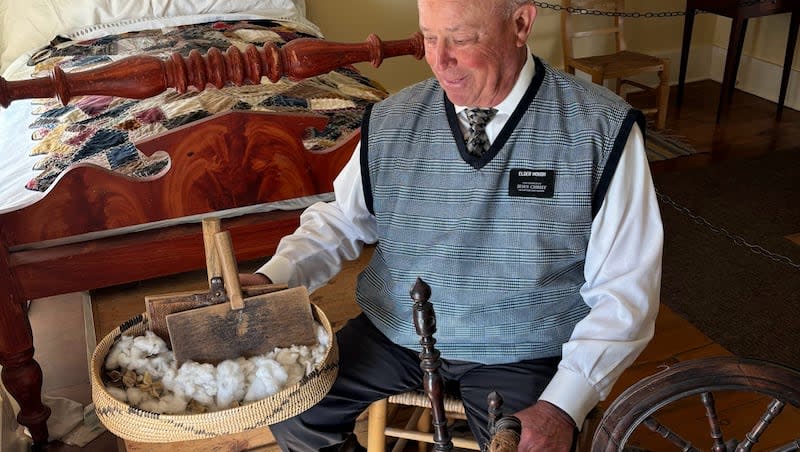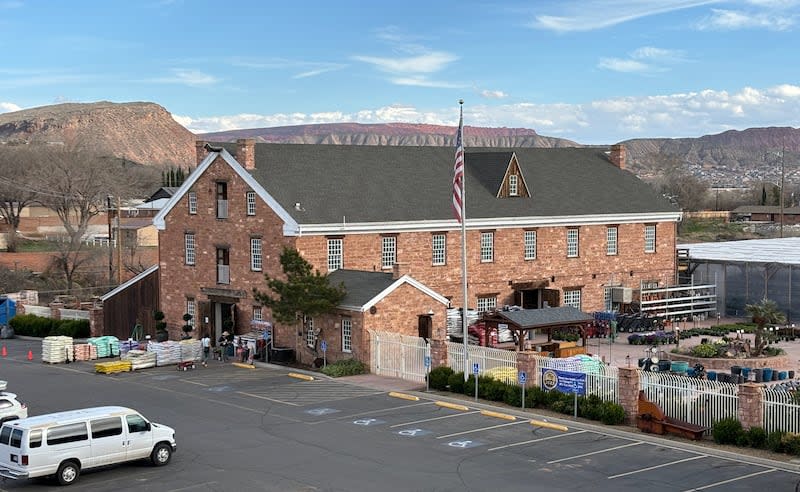It’s a long way from growing cotton to growing golf courses

- Oops!Something went wrong.Please try again later.
- Oops!Something went wrong.Please try again later.
A mere 167 years before the golf courses and the soccer fields, before Costco and Texas Roadhouse and Marriott Springhill Suites and, heaven knows, before In-N-Out Burger backed up cars to the freeway, back when a second home was your horse, when central heating was a big fire, 38 thirsty families, husband and wives, rolled down the ridge from Fort Harmony to the banks of the Virgin River to grow cotton.
Hard to imagine a landscape much different from where these sodbusters had come from. Just a few short years earlier, before they converted to The Church of Jesus Christ of Latter-day Saints and joined the pioneer exodus to Utah, they’d lived in the Southern states. There, in Mississippi and South Carolina and Arkansas and Alabama, they’d worked on lush, green plantations, where God took care of the irrigation and cotton was king.
Now, precisely because of their familiarity with cotton, they’d been hand-picked by Brigham Young to come to the hottest, most unappealing corner of the unsettled territory to see what they could manage. It was the spring of 1857. When they stopped their wagons at the place they would name Washington City, after America’s first president, exactly no one was there to greet them.
And for good reason. As Reuben Wadsworth, a local historian who writes the popular “Days” series for the St. George News, points out, “The land was not welcoming.”
Wadsworth quotes Parley P. Pratt, who in 1850 first scouted the area and reported to Brigham Young: “It is a wide expanse of chaotic matter, turned inside out and upside down by terrible convulsions in some former age … lying in inconceivable confusion — in short a country in ruins.”
But Pratt’s review wasn’t all bad. Along the banks of the Virgin River, he said, the soil was “extremely fertile” and “easily watered.”
Thus, when Brigham Young stood up in the October 1856 session of general conference and called out the names of the families selected to settle what became known as Utah’s Dixie, the Cotton Mission was born.
“They were tough people, stalwart, faithful … and too poor to leave.”
That’s Kress Staheli talking. Staheli is the current mayor of Washington. He’s a young-looking 48, looks like he’s ready to run a triathlon, dresses trendy, but his roots stretch back to nearly the beginning. His ancestors didn’t come to Utah from the Southern states, they came from Switzerland, but they were early settlers in the neighboring farm town of Santa Clara and when Kress’s great-grandfather, Franklin Staheli, needed a job as a young man, he moved next door to Washington City to work in the Washington Cotton Factory.
The factory was built in 1865, when the Cotton Mission was riding what turned out to be a brief wave of profitable possibility. Long story short: Those early Southerners, soon joined by others, did figure out how to survive and grow and irrigate cotton along the banks of the Virgin River, to the point that, by 1862, they were annually producing in excess of 100,000 pounds of cotton. But there was a Civil War going on, greatly hampering the exporting of cotton, and when the war ended three years later — the year the factory was built — cheaper cotton was again available from the South. It was the beginning of the end. By the mid-1880s, production had halved, and by 1904, the factory was shut down completely.
Today, the two-story factory building still stands in all its grandeur, at 385 W. Telegraph Street, although it is now a nursery. The only home-grown cotton you’ll find in Utah’s Dixie is at Latter-day Saint visitors centers in Washington (the old relief society building), St. George (the Brigham Young Winter Home) and Santa Clara (the Jacob Hamblin House), historic sites where missionaries, in tribute to the old days, plant cotton seeds every spring.
Farms of any kind, for that matter, are in scarce supply in the new Dixie.
“There are way more golfers than farmers these days,” says Jordan Hess, Washington’s public affairs officer.

Prosperity has arrived not from cotton, but from outdoor recreation, tourism and air conditioning. Attracting golfers, mountain bikers, hikers, red rock sightseers and baby boomers looking for a comfortable place to retire, Washington’s population has grown from around 4,000 30 years ago to nearly 40,000 today. (While next-door St. George’s population has ballooned to over 100,000). Hess guesses that 80% of the residents are first generation, including himself.
But the pulse of those old cotton growers still beats strong beneath the surface — as evidenced by Cotton Days, Washington’s weeklong celebration held every year at the end of April (this year’s event is April 22-28).
“We have a proud past and Cotton Days is how we keep our heritage alive,” says Kress Staheli, who, incidentally, is the fourth Staheli to serve as Washington’s mayor, following in a line that includes his uncle Frank Staheli, his grandfather Woodrow Wilson Staheli and his great-grandfather Franklin Staheli, the one who worked in the cotton factory.
“I don’t want to sound like some weirdo, but I kinda feel like this is as much of a calling as anything,” says the mayor, “and I’m just honored to be following in some great footsteps.
“Some would say the Cotton Mission was a failed mission,” he continues, “and maybe the Cotton Mission didn’t yield cotton in a manner that the Southern states could, but I don’t think it’s fair to judge the success of the mission by cotton production. I think it should be judged by the resiliency and quality of the people who have grown out of this desert.”
To which Wadsworth, the historian, adds: “Their failure was a lesson in fortitude and stick-to-it-iveness – a lesson current Washington County residents can learn from and apply in their own lives when the going gets tough.”
